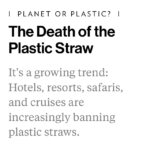 First it was recycling. Cans, bottles, paper – no problem, already had that. Ash educated EVERYONE at work & home – literally dug thru garbage & pulled out recyclable items. Disgusting but effective. Within 6 months I flipped cans. Half bag of trash, giant orange cart of recycling. This is HER planet, keep it GREEN; most everything is recyclable.
First it was recycling. Cans, bottles, paper – no problem, already had that. Ash educated EVERYONE at work & home – literally dug thru garbage & pulled out recyclable items. Disgusting but effective. Within 6 months I flipped cans. Half bag of trash, giant orange cart of recycling. This is HER planet, keep it GREEN; most everything is recyclable.
Summer 2016, bought her first home – then found forever homes for 18 foster cats & dogs.
This year we’re saying NO to straws.
Straws? This is a problem? Yep, completely serious. It’s something we use no more than 10 minutes, then discard into the trash. Most will not decompose for hundreds of years. Those that make it into our oceans – even worse. Yep, a simple straw.
If you can stomach it, watch the video below. It made me a believer.
We are grown-ups; we can drink out of a glass without a straw.
Take Action #NoPlasticStraws
- Join in and next time you out to eat, ask for no straw. Remind your server or bartender when the drink is served too. If you accidentally end up with a plastic straw, reuse it on the next drink instead of going through multiple straws.
- Purchase reusable straws that are great for on the go. There are many options available including bamboo, stainless steel, glass, and silicone. They’re easy to throw in your purse or suit coat too.
https://www.plasticpollutioncoalition.org/no-straw-please
Skip a Straw – Save a Turtle
By: Robyn Albritton, Sustainability Director, Sailors for the Sea
Straws are consistently on the top 10 lists for marine debris collected every year during the International Coastal Cleanup. It is estimated that Americans use a whopping 500 million straws per day – a number that, end-to-end, could circle the planet 2.5 times. Imagine this number compounded on a global scale.
While it seems simple, straws create a pressing threat to our oceans because they are made to be disposable, and on average are used for just 10 minutes. Plastic straws are rarely recyclable, requiring special facilities, and they almost always end up in a landfill, or worse the ocean. Over their lifespan the straw breaks down into smaller and smaller, even microscopic pieces. Pieces so small that single-celled organisms and other marine life eat them.
The plastic remains forever.









Leave a Reply